Standard [CURRENT]
ASTM F 3661:2024
Standard Guide for Assessing Fit Accommodation of Exoskeletons for Manufacturers and Designers
- Publication date
- 2024
- Original language
- English
- Pages
- 10
- Publication date
- 2024
- Original language
- English
- Pages
- 10
- DOI
- https://dx.doi.org/10.1520/F3661-24
Product information on this site:
Quick delivery via download or delivery service
Buy securely with a credit card or pay upon receipt of invoice
All transactions are encrypted
Short description
1.1 This guide covers guidelines and best practices in considering user fit and accommodation of exoskeletons. Accommodation refers to the ability of users to operate and maintain the exoskeleton safely and in the manner for the task(s) for which it was intended, as opposed to the exoskeleton users' fit to the environment (for example, using an exoskeleton while walking down the aisle of a plane). The manufacturer should specify the anthropometric characteristics of the population for which the exoskeleton was designed so that users may select the appropriate exoskeleton. This would include suggested language for identifying and clearly communicating relevant metrics regarding the fit and adjustment factors for their system, and may clearly specify the population who can use the exoskeleton safely. Appendix X1 provides databases for determining population accommodation and Appendix X2 provides an example of fit for a singular dimension. Lastly, this guide assumes the reader understands the fundamentals behind anthropometry and human biomechanics. The concepts in this guide may be appropriate for medical exoskeletons; however, medical exoskeletons have nuanced use cases which require a lot more specificity. While the guidance here may provide insight to the fit and accommodation of medical exoskeletons, the information herein is not exhaustive and should not replace treatment or oversight from a medical professional. 1.2 The values stated in SI units are to be regarded as standard. The values given in parentheses after SI units are provided for information only and are not considered standard. 1.3 This standard does not purport to address all of the safety concerns, if any, associated with its use. It is the responsibility of the user of this standard to establish appropriate safety, health, and environmental practices and determine the applicability of regulatory limitations prior to use. 1.4 This international standard was developed in accordance with internationally recognized principles on standardization established in the Decision on Principles for the Development of International Standards, Guides and Recommendations issued by the World Trade Organization Technical Barriers to Trade (TBT) Committee.
ICS
25.040.30
DOI
https://dx.doi.org/10.1520/F3661-24
Also available in
Loading recommended items...
Loading recommended items...
Loading recommended items...

